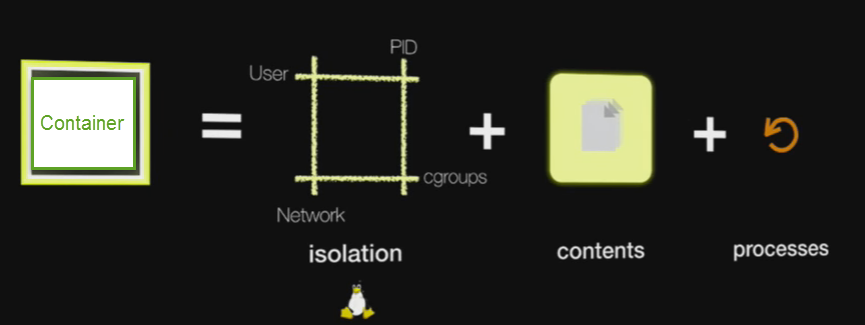Make container from scratch using Golang
- Download and build for your platform:
$ git clone https://github.com/gunjan5/container-from-scratch.git
$ cd container-from-scratch
$ make get # to download dependancies or make restore to restore Godeps saved dependancies
$ make buildruncommand format is:sudo ./cfs <action_command> <OS_image> <command_to_run_inside_the_container>- Supported OS_images provided with this repo:
BusyBox,SlitazOS,TinyCore
$ whoami
gunjan
$ pwd
/home/gunjan/go/src/github.com/gunjan5/container-from-scratch
$ sudo ./cfs run SlitazOS sh
/ # whoami
root
/ # pwd
/
/ # $ sudo ./cfs run TinyCore ls
[./cfs run TinyCore ls]
[/proc/self/exe newroot TinyCore ls]
[TinyCore ls]
bin core.gz dev etc init lib linuxrc opt root sbin tmp usr var- Start the CFS server
sudo ./cfs server - REST calls:
(GET) 127.0.0.1:1337/containers
(GET) 127.0.0.1:1337/history
(POST) 127.0.0.1:1337/run
-
JSON structure examples:
// Run a new container { "state": "run", "image": "BusyBox", "command": "pwd" }
//Stop a running container with it's Container ID { "id": "e7887770-da8e-43db-9ca1-69526d144d7c", "state": "stop" }
-
CURL call examples:
curl -H "Content-Type: application/json" -X POST -d '{"state":"run","image":"TinyCore","command":"ls"}' http://localhost:1337/run
curl -H "Content-Type: application/json" -X POST -d '{"id":"d78347b9-d7c1-4e22-b2fc-782c8111cfcb","state":"stop"}' http://localhost:1337/run
- Namespaces:
- PID:
Process isolation, so every PID namespace can have their PIDs start from 1 or 2
and can have overlap. They don't have visiblity into other PID namespaces
- MNT:
Mount namespace gives processes in the namespace their own mount table.
Mounting/unmounting doesn't affect others.
- NET:
Provides network isolation.
Network namespaces can bt connected to each other, and can talk with routing.
- UTS:
Isolation for hostname and domain name
- IPC:
Inter Process Communication isolation
- USER:
It isolates container UIDs from host UIDs/GIDs, so root user ID 0, will be mapped to a random user ID on the host.
This makes the namespace/container with root ID think it has root access (it actually does, but only limited to container respurces), but it doesn't have that on the host
- cgroups:
Control group is a Linux kernel feature that limits, accounts for, and isolates
the resource usage (CPU, memory, disk I/O, network, etc.) of a collection of processes.
If Namespace is for isolation, Cgroup is for sharing resources fairly.
- Layered Filesystem:
Multilayer filesystem, so some base layers (e.g linux base layers) can be shared by multiple containers.
Layers are usually read-only, and containers make copy if they have to modify the layer.
___ ____ ___ ___ _____ _ _ ____ __ ____ _ _ ____ ____ ____ ____ _____ __ __
/ __)( ___)/ __)() / __)( _ )( \( )(_ _) /__\ (_ _)( \( )( ___)( _ \ ( ___)( _ \( _ )( \/ )
( (__ )__) \__ \ ( (__ )(_)( ) ( )( /(__)\ _)(_ ) ( )__) ) / )__) ) / )(_)( ) (
\___)(__) (___/() \___)(_____)(_)\_) (__)(__)(__)(____)(_)\_)(____)(_)\_) (__) (_)\_)(_____)(_/\/\_)
___ ___ ____ __ ____ ___ _ _
/ __) / __)( _ \ /__\ (_ _)/ __)( )_( )
\__ \( (__ ) / /(__)\ )( ( (__ ) _ (
(___/ \___)(_)\_)(__)(__)(__) \___)(_) (_)
- This is based on @doctor_julz's blog post about containers
- Container image from @onsijoe's talk at CF Summit
